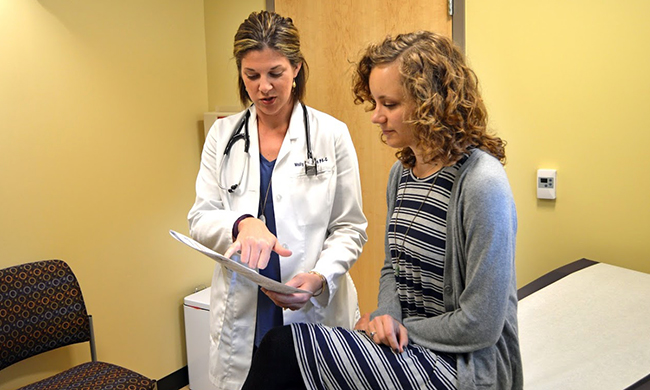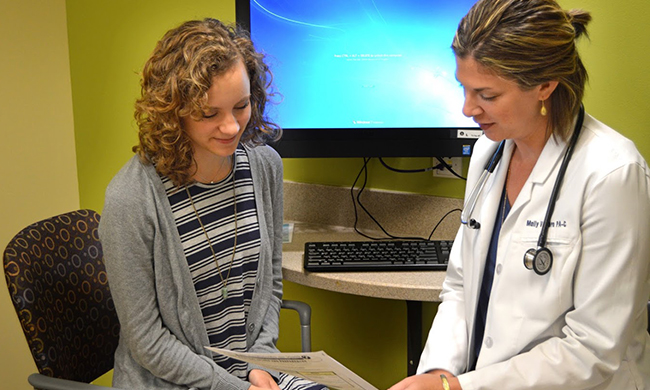DNP student implements program to reduce antibiotic overuse
NewsSUMMARY: Kristina Blyer ('16), DNP student and Associate Director of Clinical Operations at Student Health Services, has implemented a new shared decision making guide at the University Health Center.
By: Daniel Vieth '15, '17
Creative Services

According to a 2015 study by the CDC, 8 in 10 individuals in the US take an antibiotic each year. These numbers are problematic because a large portion of these prescriptions were unnecessary, and have inadvertently contributed to bacterial resistance to antibiotic treatment. Part of the reason for antibiotic overuse is misconceptions about what the drugs actually do, and pressure on medical personnel to prescribe them. Looking to help counter these trends, Kristina Blyer (‘16), a Doctor of Nursing Practice (DNP) student and Associate Director of Clinical Operations at Student Health Services, has implemented a new shared decision making guide being used at the University Health Center. This guide has already shown improvements both with antibiotic prescription rates and greater comfort in decisions made by students at the center.
After working at the University Health Center for almost 13 years and earning her master’s in nursing from JMU, Blyer decided to continue taking courses to earn her DNP. “What really interested me about the DNP is that it is practice focused,” said Blyer. “I liked being able to continue practicing in my field of nursing administration while still looking at the research and translating that into practice, which can improve health outcomes and make the patient and provider experiences better.” Her current research project goal of reducing antibiotic overuse by improving student decisional comfort is her final project in the DNP program.
According to Dr. Maria deValpine, a School of Nursing professor, and project committee chair of Blyer’s research, antibiotic overuse and bacterial resistance to the drugs has become a major global health concern. As resistance increases, the ability for medical practitioners to treat minor illnesses and injuries diminishes. “For virtually every antibiotic, almost immediately after its introduction to treatment, bacterial resistance starts to develop to it,” deValpine continued. “Over time, new antibiotics are developed, but they are more and more expensive, and they all create some degree of resistance. There is a possible future in which we will be unable to treat certain types of infections.”
One of the major contributing factors to bacterial resistance to antibiotics is the over-prescription of the drugs for upper respiratory tract infections; viral infections that are not impacted by antibiotic treatment. Despite doctors realizing that antibiotics will do not help treat these infections, they are faced with a great deal of pressure to prescribe them from the patients themselves. “Patients often have expectations that they need the antibiotics, which is why they are prescribed,” said Blyer. “People expect immediate health care, and they want fixes right now, but unfortunately viruses have to run their course.”

Looking at ways to change those perceptions, Blyer decided to focus her research on how providers and patients can communicate about those expectations. This is when she found the concept of shared decision making, which had been shown in previous studies to increase patient’s comfort with decisions made for the treatment of respiratory tract infections. “What shared decision making is really about is taking into account the patient’s expectations and preferences for treatment, and the provider’s knowledge on the risk and benefits of the treatment options,” Blyer continued. “This opens up that communication so they can work together to come up with a treatment decision, which in turn increases comfort in those decisions made.”
Using the Agency for Healthcare Research (AHRQ) SHARE Approach, Blyer created a program to train University Health Center providers on a 5-step process for shared decision making. When a student patient comes in with a possible upper respiratory tract infection, the patient and provider will go through these steps together to assess the risks and benefits of taking an antibiotic with their current symptoms. By collecting baseline data from the fall 2015 semester, and additional data after the guide was implemented in the spring of 2016, Blyer has already seen improvements to decisional comfort and reduced antibiotics prescriptions. “What we’re finding is that students are very smart, which we already know, and so when we work through this decision aid guide, the students are very quick to make their decision,” Blyer added. “Some students still decide to take the antibiotics, but that was an appropriate decision that they and their provider made together.”
“I love working at JMU, the students bring this energy and knowledge to their visits,” said Blyer. “We really are here to make their experience better, and to help them become educated and empowered about their care.” Blyer will continue collecting data for this project, and expects to graduate from the DNP program next fall. “Now that Kristina [Blyer] has implemented her [shared decision making guide], people are loving it, students and providers,” deValpine added. “We’re just very excited about this work, and really see great things in the future for [Blyer] and her influence on the field.”

